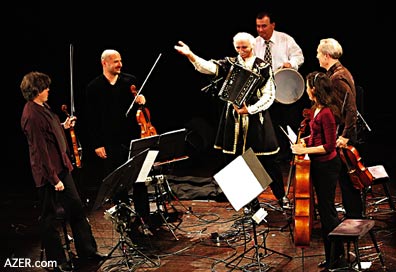|

Winter 2004 (12.4)
Page-33
Concerts: Garmon
Rahman Asadollahi Performs with World-Renown Kronos Quartet

Above: Rahman Adadollahi, an Azerbaijani from
Iran, performing on the garmon, a traditional instrument, resembling
an accordion. Rahman was commissioned by the world-renown Kronos
String Quartet to compose and perform at the San Francisco World
Music Festival on September 26, 2004. Kronos Quartet musicians,
from left to right: David Harrington (violin), John Sherba (violin),
Rahman Asadollahi (composer and garmon), Henrick Avoyan (naghara),
Hank Dutt (viola) and Jennifer Culp (cello). The Quartet has
been working together for 30 years. Photo: Jim Block
On September 26, 2004, Rahman Asadollahi, an Azerbaijani from
Iran, took center stage with his garmon (a traditional instrument
resembling the accordion) at the 2004 San Francisco World Music
Festival (SFWMF).
Asadollahi had been commissioned by the world-renown Kronos String
Quartet to compose and perform with them.
  Left: From "Azerbaijan Music Instruments"
by Majnun Karimov, 2003. Yeni Nasil. Left: From "Azerbaijan Music Instruments"
by Majnun Karimov, 2003. Yeni Nasil.
Asadollahi's compositions included "Garmon: Yanar Odlaryurduna"
(Garmon: Land of Fire, meaning Azerbaijan, 2004), and "Mugham
Bayati Shiraz" (2004). Both works were World Premiers commissioned
by Kronos.
The story of the creation of these works began when Kronos Quartet
contacted Kutay Derin Kugay, Director of the San Francisco World
Music Festival, who had produced Asadollahi's CD "Ana"
(7/8 Music Productions, 2000). Kronos wanted to perform with
Asadollahi. Could he write a piece for them? It would be the
first time a traditional Azerbaijani composition had ever been
commissioned by a Western classical quartet at a World Festival.
Asadollahi prepared and sent
the recording of his new works for Kronos. However, at their
first rehearsal, they all realized that the garmon was tuned
differently than orchestral instruments such as the violin, viola
and cello. Mugham music (traditional modal music) incorporates
microtones, which have not existed in Western music since the
1600s. Of course, violins, like most unfretted instruments, are
technically capable of playing them. After intensive work and
transcription and arrangement, the work was finally ready for
the premiere.
Without question, Rahman Asadollahi's sold out performance with
the Kronos Quartet was a resounding success, ending with a standing
ovation from the audience.
And the success continues. On February 18, 2005, Asadollahi will
again be performing with the Kronos Quartet at Stanford University,
as part of the Stanford Lively Arts program. In March 2006, Kronos
and Asadollahi will perform these works together at Carnegie
Hall in New York.
For more than 30 years, the Kronos Quartet has become one of
the most celebrated and influential ensembles of our time, performing
thousands of concerts worldwide, releasing more than 40 recordings
of extraordinary breadth and creativity, collaborating with many
of the world's most eclectic composers and performers, and commissioning
hundreds of works and arrangements for string quartet.
Kronos' work has also garnered numerous awards, including a Grammy
for Best Chamber Music Performance (2004) and "Musicians
of the Year" (2003) from Musical America. The Quartet spends
five months of each year on tour, appearing in concert halls,
clubs, and festivals around the world including the BAM Next
Wave Festival, Barbican in London, UCLA's Royce Hall, Amsterdam's
Concertgebouw and Sydney's Opera House.
Asadollahi now lives in Los Angeles. In 1995, he distinguished
himself, taking First Prize among 650 players at the "All
European Accordion and Harmonica Championship" in Switzerland.
For information about Asadollahi, or for CDs visit: seveneighths.com/rahman_asadollahi.htm.
Back to Index AI 12.4 (Winter
2004)
AI Home
| Search | Magazine
Choice
| Topics
| AI Store | Contact us
Other Web sites
created by Azerbaijan International
AZgallery.org | AZERI.org | HAJIBEYOV.com
|


